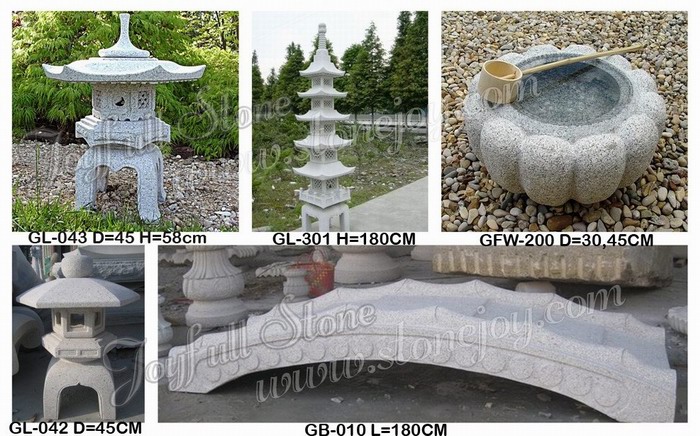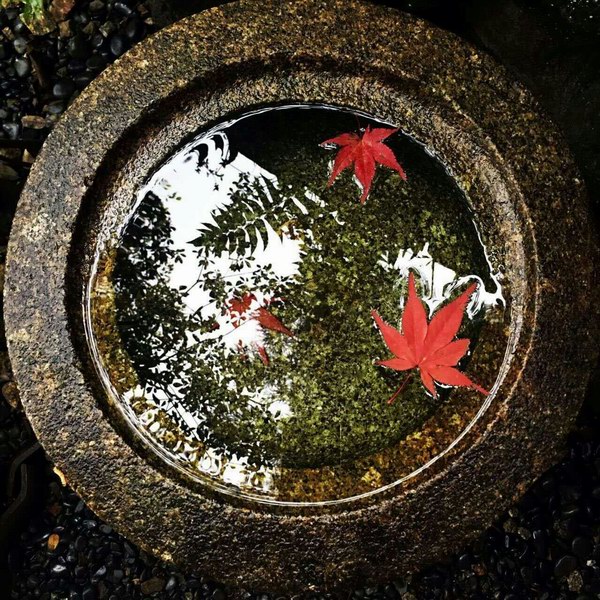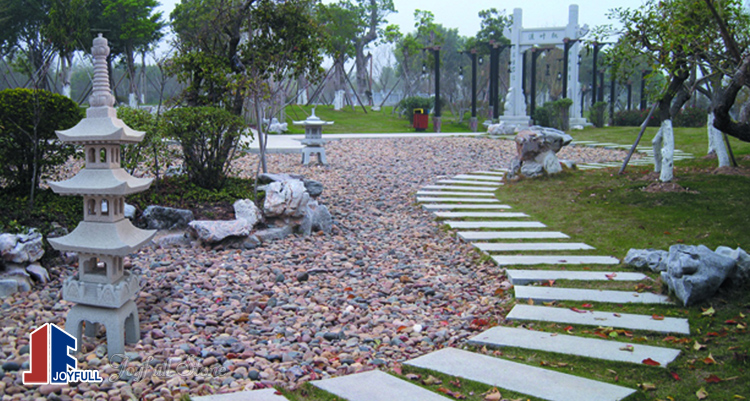How To Create A Japanese Garden?
How To Create A Japanese Garden?
Wouldn’t it be nice to have a place to relax and feel peaceful? That is exactly what happens when you create your own Japanese garden.
Traditional Japanese gardens are designed for peaceful contemplation. They draw heavily on Buddhist, Shinto and Taoist philosophies and strive to provide a spiritual haven
for visitors. The primary focus of an Oriental garden is nature. The elements of a Japanese garden mimic or symbolize natural elements. Thus, geometric shapes and artificial
stone are not common in Asian landscape design. The more natural and harmonious a garden is, the more conducive it is to contemplation.
There are four essential elements used in Japanese garden design: rocks, water, plants, and ornaments. When selecting and arranging these elements in your space, it's
important to keep in mind the main design principles of a Japanese garden, which include asymmetry, enclosure, borrowed scenery, balance and symbolism. These principles
will work together to create the proper balance in your Japanese garden.
传统的日式花园专为和平而设计。 他们大量借鉴佛教,神道教和道教哲学,并努力为游客提供一个精神上的天堂。 东方花园的主要重点是自然。 日
本花园的元素模仿或象征着自然元素。 因此,几何形状和人造石在亚洲景观设计中并不常见。 花园越自然,和谐,就越有利于沉思。
日本园林设计中使用了四个基本元素:岩石,水,植物和装饰品。 在您的空间中选择和布置这些元素时,务必牢记日式花园的主要设计原则,包括
不对称性,围护结构,借来的风景,平衡性和象征性。 这些原则将共同为您的日式花园创造适当的平衡。
The following elements are included in any garden designed in Japanese style.
1. Representation of a Mountain
Japanese gardens often have large stones representing the mountains. Instead of using stones, you can use boulders. Boulders look like natural mountains in the garden and
also add a new look to the garden. After partially burying the stones or boulders you can have small plants or herbs planted around the base.
2. Water Basins
Before entering the teahouses, water basins are traditionally used by guests to cleanse themselves. The water basin can be surrounded by a series of stones, which represent
separate elements. Adding a simple water fountain or basin can bring a sense of calm to the persons relaxing in the garden.
3. Representation of Water
Water is the essential element and is believed to have a soothing effect in the entire landscape design of the garden. To get the look in the garden, dig a shallow depression
and fill with dark gravel. Surround the banks with round stones and fill in with water.
4. Tea House
A traditional Japan garden has a place allocated for the teahouse. The teahouse is a very sacred space meant for conducting the tea ceremonies. Maybe we don’t bound to
that traditions, but you can designate it as a place for peace, calm and image.
5. Walkways
To mimic the meditative walk effect in your property, incorporate a walkway made up of stepping stones. This will reduce the path through the garden.
6. Rock or Zen Gardens
Japan gardens are the combination of rocks, moss and small trees. If the garden is made up of dry landscapes, then the pale sand is used to cover the ground to represent the
water and often ripples are made to get the feeling of water.
日式设计的任何花园均包含以下元素。
1.一座山的代表
日本花园经常有大石头代表山脉。除了使用石头,您还可以使用巨石。巨石看起来像花园里的天然山脉,也为花园增添了新面貌。将石头或巨石部
分掩埋后,您可以在基座周围种植小型植物或草药。
2.流域
在进入茶馆之前,传统上客人会使用水盆来清洁自己。水盆可以被一系列石头包围,这些石头代表单独的元素。添加一个简单的喷泉或水池可以为
在花园中放松的人们带来平静的感觉。
3.水的表示
水是必不可少的元素,据信在花园的整个景观设计中具有舒缓作用。要在花园里看一下,挖一个浅的凹陷并装满深色碎石。用圆石围住河岸,并加
水。
4.茶馆
传统的日本庭园有一个分配给茶馆的地方。茶馆是一个非常神圣的空间,用于举办茶道。也许我们不限于这些传统,但您可以将其指定为和平,平
静与形象的地方。
5.人行道
为了模仿您家中的冥想步行效果,请结合由垫脚石组成的走道。这将减少穿过花园的路径。
6.岩石或禅宗花园
日本的花园是由岩石,苔藓和小树组成的。如果花园是由干燥的景观组成,则使用浅沙覆盖地面以代表花园水,经常会产生波纹以获得水的感觉。
Decorating a Japanese garden on your own may seem simple at first, but in reality, it takes some professional experience and work to blend your own style. Take the help of
an expert to achieve your dream. Joyfull Stone is a professional supplier of Japanese style garden stone decorations, Lanterns, Water bowls, buddha, pagoda, stepping stone
for more than a decade. Contact or Email us now at sales@stonejoy.com for more design ideas suiting your property.
首先,自己装饰日式花园似乎很简单,但实际上,需要一些专业经验和工作来融合自己的风格。 采取帮助实现您梦想的专家。 Joyfull Stone是日式花
园石材装饰品,灯笼,水碗,佛像,宝塔,垫脚石的专业供应商十多年来。 现在通过sales@stonejoy.com与我们联系或发送电子邮件给我们,以获取
更多适合您房屋的设计想法。Japanese Garden?

Wouldn’t it be nice to have a place to relax and feel peaceful? That is exactly what happens when you create your own Japanese garden.
Traditional Japanese gardens are designed for peaceful contemplation. They draw heavily on Buddhist, Shinto and Taoist philosophies and strive to provide a spiritual haven for visitors. The primary focus of an Oriental garden is nature. The elements of a Japanese garden mimic or symbolize natural elements. Thus, geometric shapes and artificial stone are not common in Asian landscape design. The more natural and harmonious a garden is, the more conducive it is to contemplation.
There are four essential elements used in Japanese garden design: rocks, water, plants, and ornaments. When selecting and arranging these elements in your space, it's important to keep in mind the main design principles of a Japanese garden, which include asymmetry, enclosure, borrowed scenery, balance and symbolism. These principles will work together to create the proper balance in your Japanese garden.
1. Representation of a Mountain
Japanese gardens often have large stones representing the mountains. Instead of using stones, you can use boulders. Boulders look like natural mountains in the garden and also add a new look to the garden. After partially burying the stones or boulders you can have small plants or herbs planted around the base.
2. Water Basins
Before entering the teahouses, water basins are traditionally used by guests to cleanse themselves. The water basin can be surrounded by a series of stones, which represent separate elements. Adding a simple water fountain or basin can bring a sense of calm to the persons relaxing in the garden.

3. Representation of Water
Water is the essential element and is believed to have a soothing effect in the entire landscape design of the garden. To get the look in the garden, dig a shallow depression and fill with dark gravel. Surround the banks with round stones and fill in with water.
4. Tea House
A traditional Japan garden has a place allocated for the teahouse. The teahouse is a very sacred space meant for conducting the tea ceremonies. Maybe we don’t bound to that traditions, but you can designate it as a place for peace, calm and image.
5. Walkways

To mimic the meditative walk effect in your property, incorporate a walkway made up of stepping stones. This will reduce the path through the garden.
6. Rock or Zen Gardens
Japan gardens are the combination of rocks, moss and small trees. If the garden is made up of dry landscapes, then the pale sand is used to cover the ground to represent the water and often ripples are made to get the feeling of water.
Decorating a Japanese garden on your own may seem simple at first, but in reality, it takes some professional experience and work to blend your own style. Take the help of an expert to achieve your dream. Joyfull Stone is a professional supplier of Japanese style garden stone decorations, Lanterns, Water bowls, buddha, pagoda, stepping stone for more than a decade. Contact or Email us now at sales@stonejoy.com for more design ideas suiting your property.
Wanting to decorate your garden, but don’t know where to start?
Well, our range of Japanese garden stone lanterns and basins can help you achieve the look you are after.
Our Japanese garden lanterns are made by hand from natural materials such as granite and natural stone. We also have a beautiful range of stone basins available that will give your garden the perfect finishing touch!
Reach Joyfull Stone for more about the Japanese garden stone decor.





